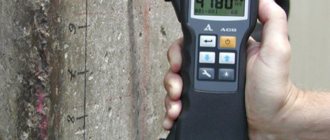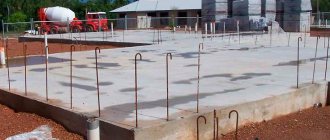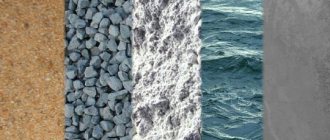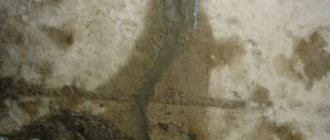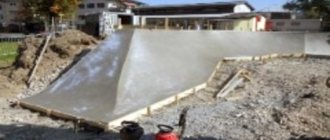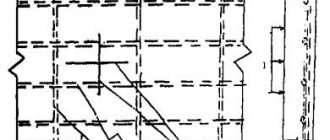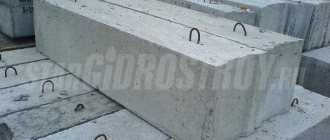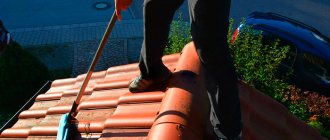Concrete is one of the most common types of structures; the durability and reliability of the entire object largely depends on its quality and strength. It is not surprising that determining the strength properties is a very important task in the process of constructing an object and putting it into operation. For this, various methods and types of equipment are used, which is what we will consider in this review.
In the photo - thanks to the advent of high-tech devices, determining strength has become much easier these days
Basic methods of testing concrete
It is worth noting that the equipment of this group can be used to test the strength of both concrete and brick. Strength refers to the ability of a material to resist destruction under the influence of internal stress and various external factors; the higher the resistance, the more reliable and durable the structure.
Strength testing equipment can be very large
You can check in two ways:
- Destructive: the essence of this method is that pre-prepared workpieces are crushed in a special press . These can be cubes that are cast from controlled concrete or cores - cylindrical fragments, which can be obtained by diamond drilling holes in concrete and removing the fragment.
To obtain a core, it is necessary to drill concrete
- The second option is to use a device to determine the strength of concrete using a non-destructive method . Such equipment measures physical quantities that have a direct impact on the strength of concrete and recalculates them, giving the necessary indicators. Naturally, the better the equipment, the smaller the error and the higher the accuracy of the research.
Areas of use
Electronic concrete strength meters are widely used in construction, production of building materials, quality control, reliability level and degree of wear of structures in use. These are load-bearing elements of buildings, hydraulic structures, bridges, any reinforced concrete products (slabs, rings, blocks). They are also ergonomic, easy to use, and do not require constant additional maintenance costs. Flaw detectors allow not only to determine the grade of concrete, but also to identify hidden defects - voids, cracks, foreign inclusions.
Types of devices
When carrying out measuring activities, one of two main types of measuring equipment is most often used. Naturally, doing the work yourself implies this particular option, since the price of a special press is very high, and there is no point in keeping it if you do not have a special testing laboratory to provide services for measuring strength and other indicators.
Determination of strength by mechanical method
If non-destructive testing (NDT) is carried out mechanically, then the main regulatory act that must be followed is GOST 22690-88 “Concrete. Determination of strength by mechanical NDT methods.” This document sets out the rules for testing both heavy and light concrete with limiting strength values not exceeding the range from 5 to 100 MPa.
This group of devices includes several main types of equipment, which differ in the way they determine certain indirect characteristics.
These may be the following indicators:
- Impact energy with a special striker.
- The value of the rebound of the striker from the striker pressed against the wall.
- The size of the impact mark left behind.
- An indicator of the force required to destroy a small area on the edges of a structure or to pull out a fixed anchor bolt.
The device may consist of a striker and a control unit, or everything can be located in the striker (the most modern options are implemented this way)
Features of measurements using a particular method depend on many factors, so the operating instructions for the device are required to be studied. Let's consider the most popular testing option - the elastic rebound method.
The technology looks like this:
- The measuring unit must be located perpendicular to the surface; the greater the skew, the greater the measurement error, do not forget about this.
The force must be applied perpendicularly to ensure accurate measurements
- The test must be carried out on different parts of the surface; for correct measurements, you must have at least 5 values and determine the arithmetic average.
- Using a special formula, the strength indicator of a particular structure is calculated. In fact, everything is quite simple and, following the recommendations and requirements of the instructions, you can carry out high-quality measurements even without having the appropriate practice.
Modern devices are very compact and easy to use
Important! In order for the indicators to be accurate and correct, do not forget that the minimum thickness of the concrete structure should not be less than 100 mm.
Using the ultrasonic method
When using this method of calculating the strength indicators of concrete or brick, all requirements for measurements and the procedure for their implementation are determined by GOST 17624-87 “Concrete. Ultrasonic method for determining strength." It is worth noting that using this method you can measure almost all types of concrete, this makes this option as universal as possible.
An ultrasonic device for determining the strength of concrete is simple and easy to use
Using ultrasound, you can measure both the performance of finished structures and materials that have not yet achieved optimal strength. That is, you can monitor the curing process of the material.
The features of this type of measurement are as follows:
- The method itself is based on the physical relationship between the strength of concrete and the speed of propagation of sound vibrations through it. This relationship can be expressed in the form of a formula, graph or table; experts call it a “calibration characteristic”. This indicator is determined separately for each measurement object; during the verification process, surface or through sounding is used.
- Based on the results of checking and selecting calibration characteristics, the main test activities are carried out, and they must be carried out in the same way as the verification ones.
- Based on the obtained indicators, the actual strength of a particular section of the concrete structure is determined.
Important! The more accurately the calibration characteristic is determined, the higher the accuracy of the final results will be.
Checking may be needed in a variety of cases: from determining the reliability of a structure to calculating the dynamics of hardening of concrete material. If reinforced concrete is to be cut with diamond wheels, it is also advisable to measure the strength and select the optimal type of wheel for concrete.
Devices can have very different configurations; it is important that the measurement accuracy is as high as possible
Technical Features and Benefits
Depending on the specific model, the device may differ in the following technical features and advantages:
- Testing method – rib chipping, separation with chipping, pulling out of spiral anchors, ultrasonic wave propagation intensity, magnetic influence
- Wide measurement range – from 0.1 to 150 MPa
- Built-in non-volatile memory with the ability to save results
- Availability of USB connectors for transferring data to a computer, built-in simple and intuitive interface
- Ability to set individual calibration settings for working with various materials and testing for various parameters
- Availability of color or black and white displays, visualization of results
- For ultrasonic devices, the clamping force is not critical and does not affect the accuracy of the results
- Expanded equipment, including transport bags, cases, belts, control samples, etc.
Each concrete strength meter, which can be purchased directly from the catalog pages, is supplied ready-to-use with a guarantee and a full package of documentation.
Impact methods
One of the most common methods of non-destructive testing of concrete strength is the impact pulse method.
This method records the impact energy that occurs at the moment the striker hits the concrete surface.
The equipment used in this method is characterized by relatively low weight and volume of space occupied. Yes, and determining the strength of concrete using the shock pulse method is quite simple. All results are expressed in the same units as compressive strength. According to the measurements, the class of concrete is also determined, strength is measured at different angles to the plane of the object, and the results are transferred to a computer.
Koshkarov's hammer is one of the methods for determining the strength of concrete.
Shock pulses are low-energy waves resulting from impact, which are generated by bearings, rolling due to changes in pressure and impact in the rolling zone during the operation of the bearings and propagate in the bearing elements, bearing mechanism assembly and parts in contact with it.
Using the shock pulse method has the following main functions:
- advance warnings about changes in bearing lubrication conditions to carry out lubricant replacement work according to its actual condition;
- advance warnings about changes in the operation of bearings due to the influence of various external factors in order to take measures to eliminate them in a timely manner (for example, imbalance, overloads, etc.);
- advance warnings about defects occurring in bearings in order to carry out work on their timely replacement;
- minimizing equipment downtime;
- minimizing risks associated with equipment failures. Ensuring reliable operation.
The springback method is the amount of rebound resulting from the impact of the impactor on the concrete surface. The Schmidt sclerometer and its various analogues are the most common instruments for testing with this method. Measuring the surface hardness of a concrete structure is the basis of the elastic rebound method and the plastic deformation method.
Initially, the hardness of metals was determined by the elastic rebound method. Tests are carried out using instruments called sclerometers, which are spring-type hammers with stamps in the form of a sphere. The spring system of the hammer does not prevent the hammer from freely rebounding after impact with a concrete surface or with a steel plate pressed against the concrete. A scale with an arrow on the device records the path of the striker during its rebound. The hammer impact force must be no less than 0.75 Nm, the radius of the spherical stamp at the end of the hammer must be no less than 5 mm. Every 500 blows the device is calibrated (checked).
As the test progresses, after each impact a measurement is taken according to the instrument scale (the accuracy should be one division). The result is recorded in a special work log. The requirements for the preparation of test sites (location, number of impact sites and experiments for constructing calibration curves) are identical to the requirements of the plastic deformation method.
Diagram of the destruction of a concrete beam.
The plastic deformation method is characterized by measuring the imprint left on the concrete after hitting it with a steel ball. This method of measuring strength is already outdated, but it is still used today, since expensive equipment is not required for testing.
The Kashkarov hammer is the most widely used for carrying out such tests. The operating principle is relatively simple. The hammer is equipped with a special removable metal rod, which has a certain already known strength. This hammer is used to hit a concrete surface. The impact marks on the rod and concrete are then measured using an angular scale. The strength of concrete is calculated by the ratio of the size of the prints.
Devices for determining the strength of concrete by plastic deformation are based on the effect of pressing a stamp into a concrete surface upon impact or static pressure of a certain force. Their use is limited. Impact devices are hand or spring hammers with a stamp in the form of a sphere (ball) and pendulum devices with a stamp in the form of a ball or disk.
Instrument stamps must be:
- hardness not less than HRC60;
- roughness Ra less than 0.32 microns. Maximum stamp wear – up to 5 microns;
- with a ball diameter of not less than 10 mm;
- the impact force must be at least 125 Ncm;
- the thickness of the disk is not less than 1 mm.
